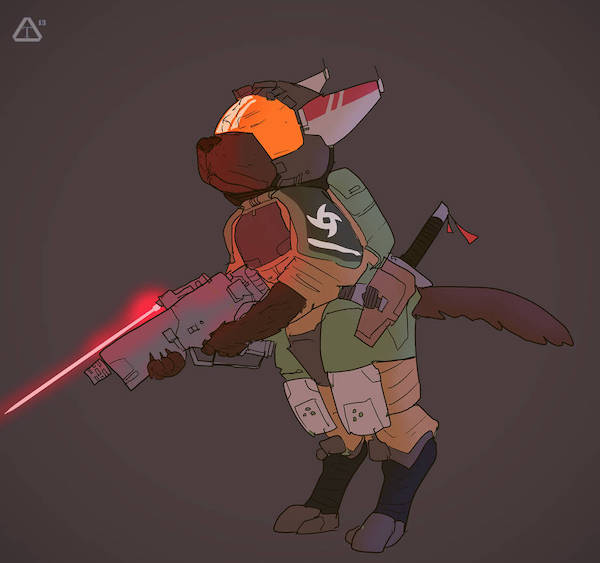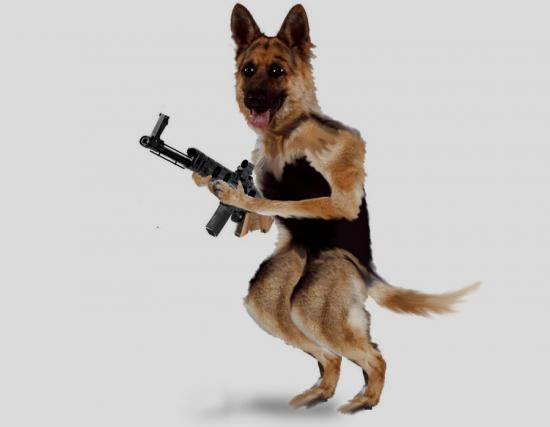BY LETTER
Kriavuks
Sapient war-dogs | |
 Image from Tharsis13 | |
| ...and let slip the dogs of war | |
Early Terragen attempts at gene splicing focused on creating laborers, playthings or soldiers. The Kriavuks are a prime example of the latter. This large and varied clade remains one of the most common canine splice-provolve groups in existence.
History
Dogs were a logical choice when scientists wanted to create genetically modified non-humanoid soldiers. Kriavuks are a refinement of the work that produced Neo-dogs, and may be one of the first fully sapient sub-clades in the Neo-dog line. The linguistic derivation of the clade name has been lost to antiquity. The "dogs of war" claim that they were named for an ancient battle cry.Kriavuks expanded across space in whatever directions Terragens took their wars. The clade was once one of the most common provolve groups in existence, but advancements in gengineering and sharp decreases in military action rendered the Kriavuks' original niche obsolete. They are now rare in the Civilized Galaxy, though they are somewhat more common on the frontier.
Appearance and Capabilities
Kriavuks are derived from Old Earth dog stock. Most appear as a mixture of several types of dog, but some bear a resemblance to one of the ancient breeds. They typically mass 70-100 kg. Height at the shoulder is about 0.8-1.2 meters when they are on all fours. They can sometimes be mistaken for unmodified dogs in this stance. When they stand or move bipedally their height more than doubles. Females tend to be smaller than males. Eye color is usually brown, blue or gray; yellow is rare. The coat can be any shade of brown, gray, blond or red, and white or black fur is also fairly common. It may be one color, boldly patterned or shade to a lighter color on the face and underbelly. Kriavuks have little use for clothing beyond some kind of equipment harness. They never wear collars, but members of the same pack sometimes wear matching bandannas around their necks.The most notable feature of Kriavuks — and the one that their designers had the most trouble with — is their unusual bone structure. The shoulders, waist and hips are designed to allow for both quadrupedal and bipedal locomotion. They prefer to stay on four legs, especially for running, but will readily stand upright when they need their hands free. Kriavuk forelimbs are modified to allow for manipulation, something which slows down their running speed somewhat by comparison with that of dogs.
Kriavuks have all of the sensory capabilities of their canine ancestors. Their hearing is superhumanly acute and extends into the near ultrasonic. They also possess better night vision than human baselines do thanks to the tapetum (a reflective membrane behind the retina) that they retain from their subsapient heritage. Most amazing is their sense of smell, which is equal to that of unmodified dogs. Human genes spliced into the Kriavuk sensorium improve their visual acuity beyond the canine norm and allow them to see in color. Color vision diminishes in low light conditions so as to improve night vision, but not as sharply as it does in human baselines.
In addition to canine sensory powers Kriavuks have dog-like physical attributes. They can run at up to 55 k.p.h. while on all fours or up to 40 k.p.h. on two legs. They also retain their ancestors' sharp teeth and crushing jaws; nearly all Kriavuks can bite through unmodified bone. Even the weakest Kriavuks are stronger than most human baselines, and the strongest can drag over half a ton with great effort. Kriavuks retain canine level stamina; they can jog for several hours at a time with no ill effects.
The problem of enhancing the baseline species' mental abilities while retaining an appearance that allows Kriavuks to pass for unmodified dogs proved to be especially problematical. The designers settled on a 25% increase in cranial volume and brain mass, and some improvements in overall neural architecture. All of the added cerebral tissue was devoted to neocortex, and the existing brain matter was enhanced with additional convolutions. These modifications were barely enough to raise the Kriavuks to sapience; their intelligence is somewhat inferior to that of human baselines. Their nature as pack animals does, however, give them unusual aptitude for small unit tactics.
The same pack mentality that makes Kriavuks superb tacticians also makes them group-dependent. Long periods of isolation make most of them profoundly uncomfortable and some may suffer severe psychological trauma under these conditions. Even those who can tolerate solitude greatly prefer the company of other sophonts. Kriavuk psychology demands a clear hierarchy; all of them either seek to establish their own dominance or to curry favor with whoever is in charge. This tendency makes Kriavuk society vulnerable to memetic assault by manipulation of those whom they consider authority figures. The designers never corrected this trait because they considered it and the resulting resistance to memetic subversion from those outside the chain of command to be valuable features.
Although upright stance allows Kriavuks to climb — something that their predecessors could never do — they are poor climbers and are uncomfortable with heights. Their forelimbs are also a compromise between hands and paws. Kriavuks are capable of both manipulation (including throwing) and a quadrupedal gait, but they are not as adept as baselines at the former or as dogs at the latter. Tools and weapons intended for Kriavuk use are always designed so as to require little or no fine manipulation. They greatly prefer neural interfaces for computer use because most manual interfaces are difficult for them to use.
 Image from Steve Bowers | |
| Another Kriavuk variant from early in the timeline | |
Culture
Kriavuks have very little culture of their own. They integrate fully into the cultures of whatever polity they live in. They prefer to segregate themselves in neighborhoods that are predominantly rianth, splice or provolve but otherwise take on mainstream cultural mores. Their one unique cultural expression is a form of music called Monshrek. This hard-driving primal style is played (usually at excessively high volume) on instruments whose range extends into what is (for human baselines) the near ultrasonic. Very few other sophonts consider Monshrek pleasant to listen to, and most baselines and nearbaselines find it to be acutely painful. Audience participation is expected, and Kriavuks, especially the young, enjoy howling along with the musicians.Like many other splices and provolves Kriavuks celebrate Freedom Day. They will not fight during this holiday except to avenge crimes against their families/packs or for very generous payment.
Related Articles
Appears in Topics
Development Notes
Text by Michael Walton
Initially published on 11 December 2004.
Initially published on 11 December 2004.






